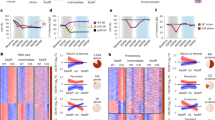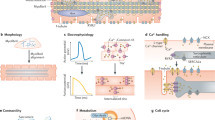Abstract
The adult mammalian myocardium has a robust intrinsic regenerative capacity because of the presence of cardiac stem cells (CSCs). Despite being mainly composed of terminally differentiated myocytes that cannot re-enter the cell cycle, the heart is not a postmitotic organ and maintains some capacity to form new parenchymal cells during the lifespan of the organism. Myocyte death and formation of new myocytes by the CSCs are the two processes that enable this organ to maintain a proper and uninterrupted cardiac output from birth to adulthood and into old age. CSCs are activated in response to pathological or physiological stimuli, whereby they enter the cell cycle and differentiate into new myocytes (and vessels) that significantly contribute to changes in myocardial mass. The future of regenerative cardiovascular medicine is arguably dependent on our success in dissecting the biology and mechanisms regulating the number, growth, differentiation, and aging of CSCs. This information will generate the means to manipulate CSC growth, survival, and differentiation and, therefore, will provide the tools for the design of more physiologically relevant clinical regeneration protocols. In this article, we review the developments in cardiac cell biology that might, in our opinion, have a broad impact on cardiovascular medicine.
Key Points
-
Cardiac stem cells (CSCs) enable the heart to have the capacity to form new parenchymal cells during the lifespan of the organism; the heart is no longer considered a postmitotic organ
-
Myocyte death and the formation of new myocytes by CSCs enable the heart to maintain a proper and uninterrupted cardiac output from birth to adulthood and into old age
-
The adult heart harbors a 'true' CSC population, which is Oct-4pos, exhibits primitive characteristics, possesses 'stemness' genes, and is pluripotent
-
CSCs are activated, enter the cell cycle, and differentiate into new myocytes and blood vessels that significantly contribute to changes in myocardial mass during physiological or pathologic remodeling
-
The success of future physiologically relevant clinical regeneration protocols will require solid basic science data regarding the molecular biology and mechanisms regulating the number, growth, differentiation, and aging of CSCs
This is a preview of subscription content, access via your institution
Access options
Subscribe to this journal
Receive 12 print issues and online access
$209.00 per year
only $17.42 per issue
Buy this article
- Purchase on Springer Link
- Instant access to full article PDF
Prices may be subject to local taxes which are calculated during checkout


Similar content being viewed by others
References
Anversa P and Kajstura J (1998) Ventricular myocytes are not terminally differentiated in the adult mammalian heart. Circ Res 83: 1–14
Nadal-Ginard B et al. (2003) Myocyte death, growth, and regeneration in cardiac hypertrophy and failure. Circ Res 92: 139–150
Anversa P and Nadal-Ginard B (2002) Myocyte renewal and ventricular remodelling. Nature 415: 240–243
Beltrami AP et al. (2003) Adult cardiac stem cells are multipotent and support myocardial regeneration. Cell 114: 763–776
Oh H et al. (2003) Cardiac progenitor cells from adult myocardium: homing, differentiation, and fusion after infarction. Proc Natl Acad Sci USA 100: 12313–12318
Matsuura K et al. (2004) Adult cardiac Sca-1-positive cells differentiate into beating cardiomyocytes. J Biol Chem 279: 11384–11391
Messina E et al. (2004) Isolation and expansion of adult cardiac stem cells from human and murine heart. Circ Res 95: 911–921
Martin CM et al. (2004) Persistent expression of the ATP-binding cassette transporter, Abcg2, identifies cardiac SP cells in the developing and adult heart. Dev Biol 265: 262–275
Laugwitz KL et al. (2005) Postnatal isl1+ cardioblasts enter fully differentiated cardiomyocyte lineages. Nature 433: 647–653
Pfister O et al. (2005) CD31− but Not CD31+ cardiac side population cells exhibit functional cardiomyogenic differentiation. Circ Res 97: 52–61
Tomita Y et al. (2005) Cardiac neural crest cells contribute to the dormant multipotent stem cell in the mammalian heart. J Cell Biol 170: 1135–1146
Torella D et al. Resident cardiac stem cells. Cell Mol Life Sci, in press
Potten CS and Loeffler M (1990) Stem cells: attributes, cycles, spirals, pitfalls and uncertainties. Lessons for and from the crypt. Development 10: 1001–1020
Torella D et al. (2006) The cardiac stem cell: the adult mammalian heart harbours oct-4pos cardiac stem cells with very broad in vivo and in vitro developmental potential. Circulation, 114 II: 303
Pan GJ et al. (2002) Stem cell pluripotency and transcription factor Oct4. Cell Res 12: 321–329
Overy HR and Priest RE (1966) Mitotic cell division in postnatal cardiac growth. Lab Invest 15: 1100–1103
Kajstura J et al. (1998). Myocyte proliferation in end-stage cardiac failure in humans. Proc Natl Acad Sci USA 95: 8801–8805
Torella D et al. (2005) Cardiac stem and progenitor cell biology for regenerative medicine. Trends Cardiovasc Med 15: 229–236
Torella D et al. (2004) Cardiac stem cell and myocyte aging, heart failure, and insulin-like growth factor-1 overexpression. Circ Res 94:514–524
Brenner A et al. (1998) Increased p16 expression with first senescence arrest in human mammary epithelial cells and extended growth capacity with p16 inactivation. Oncogene 17: 199–205
Ellison GM et al. (2005) Cardiac stem-progenitor cell resistance to hyper-adrenergic stimulation produces rapid left ventricular function recovery after isoproterenol-induced diffuse myocardial damage [abstract]. Circulation 112 II: 277
Urbanek K et al. (2003). Intense myocyte formation from cardiac stem cells in human cardiac hypertrophy. Proc Natl Acad Sci USA 100: 10440–10445
Goldspink DF et al. (2004). Catecholamine-induced apoptosis and necrosis in cardiac and skeletal myocytes of the rat in vivo: the same or separate death pathways. Exp Physiol 89: 407–416
Kemi OJ et al. (2002) Intensity-controlled treadmill running in mice: cardiac and skeletal muscle hypertrophy. J Appl Physiol 93: 1301–1309
Torella D et al. (2006) Exercise training activates cardiac stem/progenitor cells through the induction of growth factor production by the myocardium [abstract]. Eur Heart J 27 (Suppl): 444
Mendez-Ferrer S et al. (2006) Resident progenitors and bone marrow stem cells in myocardial renewal and repair. Nat Clin Pract Cardiovasc Med 3 (Suppl 1): S83–S89
Torella D et al. (2006) Testing regeneration of human myocardium without knowing the identity and the number of effective bone marrow cells transplanted: are the results meaningful? J Am Coll Cardiol 48: 417
Author information
Authors and Affiliations
Corresponding author
Ethics declarations
Competing interests
The authors declare no competing financial interests.
Rights and permissions
About this article
Cite this article
Ellison, G., Torella, D., Karakikes, I. et al. Myocyte death and renewal: modern concepts of cardiac cellular homeostasis. Nat Rev Cardiol 4 (Suppl 1), S52–S59 (2007). https://doi.org/10.1038/ncpcardio0773
Received:
Accepted:
Issue Date:
DOI: https://doi.org/10.1038/ncpcardio0773
This article is cited by
-
Skeletal muscle-derived interstitial progenitor cells (PICs) display stem cell properties, being clonogenic, self-renewing, and multi-potent in vitro and in vivo
Stem Cell Research & Therapy (2017)
-
Fetal heart extract facilitates the differentiation of human umbilical cord blood-derived mesenchymal stem cells into heart muscle precursor cells
Cytotechnology (2016)
-
Systems-Based Technologies in Profiling the Stem Cell Molecular Framework for Cardioregenerative Medicine
Stem Cell Reviews and Reports (2015)
-
A Review of Human Pluripotent Stem Cell-Derived Cardiomyocytes for High-Throughput Drug Discovery, Cardiotoxicity Screening, and Publication Standards
Journal of Cardiovascular Translational Research (2013)
-
Cardiovascular surgery for realization of regenerative medicine
General Thoracic and Cardiovascular Surgery (2012)



